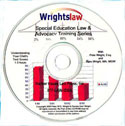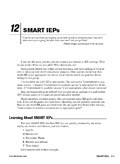| August 12 , 2008
ISSN: 1538-3202
Issue: 450
Subscribers: 64, 238 | |
In This Issue: |
Roadmap to the IEP: SMART Goals & Objectives
Don't Know Where You're Going? Where Did You Start?
You Cannot Measure an Attitude or State of Mind
If Goals are Not Measurable, the IEP Does Not Pass Muster
Assignment #6: Writing SMART Goals
|
The Wrightslaw Way: A Special Online Community

Wrightslaw Training
Featured Product
Understanding Your Child's
Test Scores (1.5 hrs)

To Order
Retail Price: $24.95
Wrightslaw Special: $14.95
Here is a fact about your child's test scores.
All important educational decisions - eligibility, services in your child's IEP, educational progress - are based on test scores. Not grades, not subjective observations - test scores.
To be an effective advocate, you need to know what tests measure and what test scores mean.
WOW - When I used this training about test scores, I got a new plan, a new evaluation, additional services in the IEP – all in a one hour meeting...
|
 More Resources More Resources
|
|
|
| Contact Info
Pete and Pam Wright
Wrightslaw & The Special Ed Advocate
P. O. Box 1008
Deltaville, VA 23043 |
|
 |
Website |
|
 |
|
| |
|
| Copyright
© 2008, Peter W. D. Wright and Pamela Darr Wright. All rights reserved. Please
do NOT reprint or host on your web site without explicit permission. |
|
Can you believe summer is almost over? This is your final week of Summer School for Parents. You will receive your certificate in the next issue.
If you traveled by car this summer (in spite of the price of gas), more than likely you used a map as a guide to help you find where you were going.
Your child's IEP should be your roadmap to his progress in school.
The roadmap to SMART IEPs is learning how to write SMART goals and objectives.
Clearly written SMART goals and objectives in the IEP provide you and your child's teachers with a roadmap and a clear mechanism to evaluate your child's progress.
Assignment #6: Learn to write SMART Goals and Objectives.
Psychologist, Educator, and Writer Robert Mager says "If you're not sure where you're going, you're liable to end up someplace else. If you don't know where you're going, the best made maps won't help you get there."
In this issue of the Special Ed Advocate you will learn how to determine your child's present levels of performance and write measurable annual goals that are SMART IEP goals and objectives.
Please don't hesitate to forward this issue of Summer School for Parents to other families, friends, and colleagues.

Sign up free today! l Read previous issues |
|
Don't Know Where You're Going? Where Did You Start? |
Perhaps you used "Mapquest" for directions to your vacation location. Did you enter your destination only and receive the pop-up alert "Please enter a starting location?"
The IEP must be based on your child's present levels of academic achievement and include measurable academic and functional goals.
Before writing IEP goals for your child, you need to know what your child knows and is able to do now. This is his present level of academic achievement.
What is the measurable starting point for his knowledge or skill level?
Make a list:
What is your child's level of academic achievement in reading, writing, spelling, and arithmetic?
- Can your child read the textbooks assigned to general education students in her grade?
- Are your child's reading skills two or three years below grade level on an individual educational achievement test of reading?
- Can your child read the grade level textbooks in core academic subjects?
Now look at your child's functional performance in certain areas. Assume your child is in the tenth grade.
- Can she read a job application? Can she complete the job application without assistance?
- Can she read the driver training manual? Can she pass the driving test without assistance?
- Can she read a map? A bus schedule? Can she balance a checkbook?
- Can she use the Internet to do research?
Present levels of performance (what your child can do) include baseline data from objective tests such as educational achievement tests. If you need to review Tests and Measurements, go back to Assignment #5.
Find out more about Present Levels of Academic Achievement and Functional Performance. |
back to the top |
|
| You Cannot Measure an Attitude or State of Mind |
Review your child's IEP.
Do you see goals like this: "Evan will improve in reading...increase study skills for academic success...demonstrate better writing...?"
Not good enough!
IDEA 2004 requires a statement of measurable annual goals, including academic and functional goals, designed to meet your child's needs that result form his disability. Find it on page 8, Section 1414(d)(1)(A)(II)
The IEP focuses on your child’s educational needs now, in the present. When you write goals, you think about what you need to do to accomplish the goals.
 Your child needs a SMART IEP that includes SMART Goals and Objectives. Your child needs a SMART IEP that includes SMART Goals and Objectives.
The term SMART IEPs describes IEPs that are:
S Specific
M Measurable
A Use Action Words
R Realistic and relevant
T Time-limited
Assume your child is in the fifth grade, but his reading skills are at the early third grade level. Here is a specific, measurable, time-limited goal that tells you what he can do now and what he will be able to do after one year of special education:
Present Level of Performance: Given third grade material, Evan reads 50-70 wpm with 4-6 errors.
Annual Goal: Given fifth grade material, Evan will read 120 wpm with only random errors.
To ensure that Evan meets his goal, plan to measure his progress at nine-week intervals (4 times during the school year).
After 9 weeks, given third grade material, Evan will read 110-120 wpm with 1-3 errors.
After 18 weeks, given fourth grade material, Evan will read 70-100 wpm with 1-3 errors.
After 27 weeks, given fifth grade material, Evan will read 70-100 wpm with 1-3 errors.
At the end of the year, Evan will read 120 wpm with only random errors.
Read more about writing SMART Goals and Objectives in A Game Plan: SMART IEPs.
Parents need to think of their role as watchdogs. The IDEA ensures that parents have a say in all decisions that affect their child's education. Read SMART IEPs: A Tactics and Strategy Session with Pete & Pam Wright. |
back to the top |
|
IF Goals are Not Measurable, the IEP Does Not Pass Muster |
IEP goals cannot be broad statements about what a child will accomplish in a year.
Assignment # 6: Writing SMART Goals
- Write down several statements about what you want your child to know and be able to do.
- Revise these statements into goals that are Specific, Measurable, use Action words, are Realistic, and Time-limited.
- Break down each goal into a few measurable short-term steps. Describe what the child will know or be able to do. Focus on behavior that you can count or observe.
How will you know if your child is achieving these goals? Your child's progress should be assessed objectively and often. If your goals are measurable, you will be able to observe the child's behavior.
 If you need more practice, review the homework assignments in From Emotions to Advocacy. If you need more practice, review the homework assignments in From Emotions to Advocacy.
Get a free download of Chapter 12, SMART IEPs. |
|
back to the top |
|
|




 Your child needs a SMART IEP that includes SMART Goals and Objectives.
Your child needs a SMART IEP that includes SMART Goals and Objectives.


